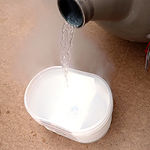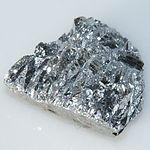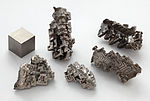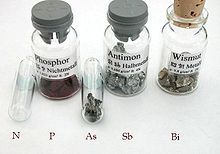- Nitrogen group
-
Group 15 Period 2 
7
N3 
15
P4 
33
As5 
51
Sb6 
83
Bi7 115
Uup A collection of nitrogen-group chemical element samples.
A collection of nitrogen-group chemical element samples.
The nitrogen group is a periodic table group consisting of nitrogen (N), phosphorus (P), arsenic (As), antimony (Sb), bismuth (Bi) and ununpentium (Uup) (unconfirmed).
In modern IUPAC notation, it is called Group 15. In the old IUPAC and CAS systems, it was called Group VB and Group VA, respectively (pronounced "group five B" and "group five A", because "V" is a Roman numeral).[1] In the field of semiconductor physics, it is still universally called Group V.[2] It is also collectively named the pnictogens.[3] The "five" ("V") in the historical names comes from the fact that these elements have five valence electrons (see below).
Like other groups, the members of this family show patterns in its electron configuration, especially the outermost shells resulting in trends in chemical behavior:
Z Element No. of electrons/shell 7 nitrogen 2, 5 15 phosphorus 2, 8, 5 33 arsenic 2, 8, 18, 5 51 antimony 2, 8, 18, 18, 5 83 bismuth 2, 8, 18, 32, 18, 5 115 ununpentium 2, 8, 18, 32, 32, 18, 5 This group has the defining characteristic that all the component elements have 5 electrons in their outermost shell, that is 2 electrons in the s subshell and 3 unpaired electrons in the p subshell. They are therefore 3 electrons short of filling their outermost electron shell in their non-ionized state. The most important elements of this group are nitrogen (chemical symbol N), which in its diatomic form is the principal component of air, and phosphorus (P), which, like nitrogen, is essential to all known forms of life.
Binary compounds of the group can be referred to collectively as pnictides. The spelling derives from the Greek πνίγειν (pnígein), to choke or stifle, which is a property of nitrogen; it can also be used as a mnemonic for the two most common members, P and N. The name pentels (from Greek πέντε, pénte, five) was also used for this group at one time, stemming from the earlier group naming convention (Group VB).
These elements are also noted for their stability in compounds due to their tendency for forming double and triple covalent bonds. This is the property of these elements which leads to their potential toxicity, most evident in phosphorus, arsenic and antimony. When these substances react with various chemicals of the body, they create strong free radicals not easily processed by the liver, where they accumulate. Paradoxically it is this strong bonding which causes nitrogen and bismuth's reduced toxicity (when in molecules), as these form strong bonds with other atoms which are difficult to split, creating very unreactive molecules. For example N2, the diatomic form of nitrogen, is used for inert atmosphere in situations where argon or another noble gas would be prohibitively expensive.
The nitrogen group consists of two non-metals, two metalloids, one metal, and one synthetic (presumably metallic) element. All the elements in the group are a solid at room temperature except for nitrogen which is a gas at room temperature. Nitrogen and bismuth, despite both being part of the nitrogen group, are very different in their physical properties. For example, at STP nitrogen is a transparent nonmetallic gas, while bismuth is a brittle pinkish metallic solid.
See also
- oxypnictide includes superconductors discovered in 2008
- ferropnictide includes oxypnictide superconductors.
Notes
- ^ Fluck, E. New notations in the periodic table. Pure & App. Chem. 1988, 60, 431-436.[1]
- ^ For example, a 2005 book is titled Properties of group-IV, III-V and II-VI semiconductors.
- ^ Edited by N G Connelly and T Damhus (with R M Hartshorn and A T Hutton), ed (2005). Nomenclature of Inorganic Chemistry: IUPAC Recommendations 2005 section IR-3.5. ISBN 0-85404-438-8. http://www.iupac.org/publications/books/rbook/Red_Book_2005.pdf.
Explanation of above periodic table slice: Nonmetals Metalloids Poor metals atomic number in red are gases atomic number in black are solids solid borders are primordial elements (older than the Earth) dotted borders are radioactive, synthetic elements Periodic tables Layouts - Standard
- Large table
- Inline f-block
- Vertical
- Text only
- Metals and nonmetals
- Blocks
- Valences
- Extension beyond the 7th period
- Large extended table
- Electron configurations
- Electronegativities
- Alternatives
- Crystal structure
- Discovery periods
List of elements by - Name etymology (symbol)
- Discovery
- Oxidation state
- Abundance (in humans)
- Nuclear stability
- Hardness
- Atomic properties
- Production
Groups Other element categories - Periods
- Metals
- Transition metals
- Metalloids
- Nonmetals
- Lanthanides
- Actinides
- Rare earth elements
- Platinum group metals (PGMs)
- Post-transition metals
- Refractory metals
Blocks Periods Pnictogens Nitrogen
N
Atomic Number: 7
Atomic Weight: 14.0067
Melting Point: 63.29 K
Boiling Point: 77.36 K
Specific mass: 0.0012506 g/cm3
Electronegativity: 2.55Phosphorus
P
Atomic Number: 15
Atomic Weight: 30.973762
Melting Point: 317.25 K
Boiling Point: 553 K
Specific mass: 1.82 g/cm3
Electronegativity: 2.19Arsenic
As
Atomic Number: 33
Atomic Weight: 74.92160
Melting Point: 1090.15 K
Boiling Point: 887 K
Specific mass: 5.776 g/cm3
Electronegativity: 2.18Antimony
Sb
Atomic Number: 51
Atomic Weight: 121.760
Melting Point: 904.05 K
Boiling Point: 1860 K
Specific mass: 6.685 g/cm3
Electronegativity: 2.05Bismuth
Bi
Atomic Number: 83
Atomic Weight: 208.98040
Melting Point: 544.67 K
Boiling Point: 1837 K
Specific mass: 9.807 g/cm3
Electronegativity: 2.02Ununpentium
Uup
Atomic Number: 115
Atomic Weight: 288
Melting Point: ? K
Boiling Point: ? K
Specific mass: ? g/cm3
Electronegativity: ?Categories:- Chemical element groups
- Periodic table
- Pnictogens
Wikimedia Foundation. 2010.
